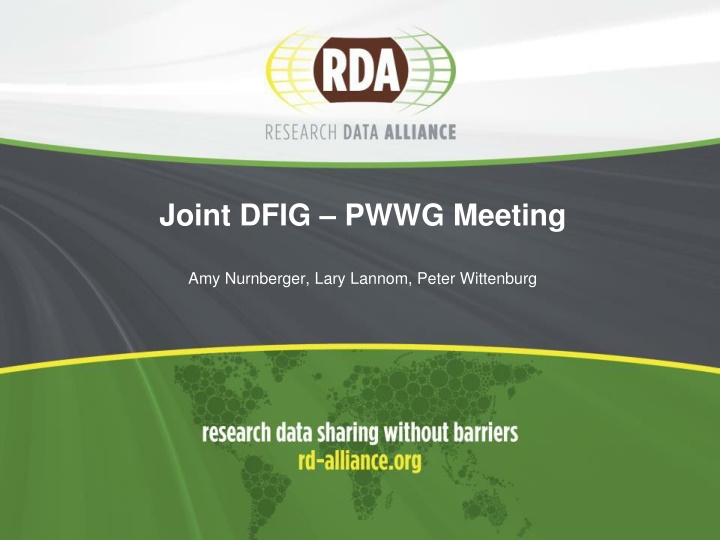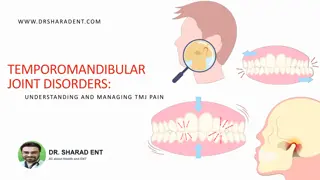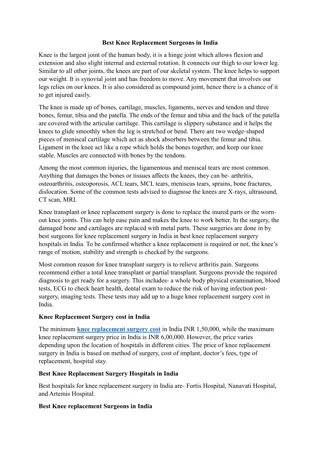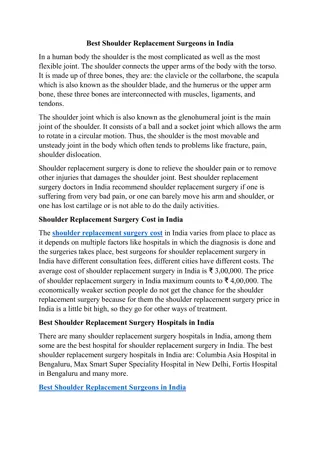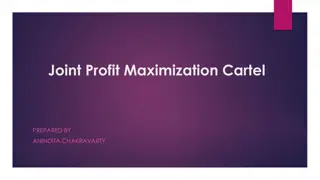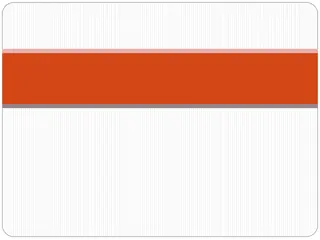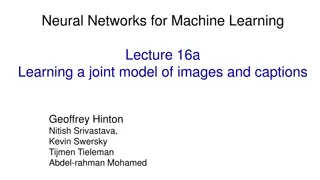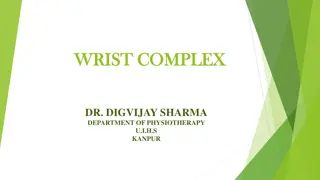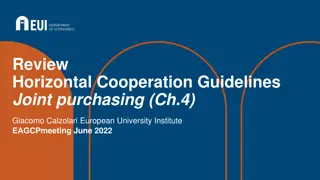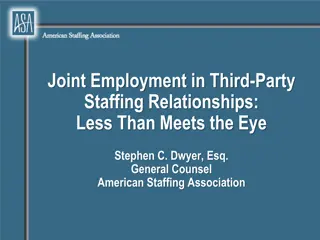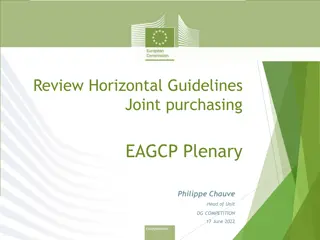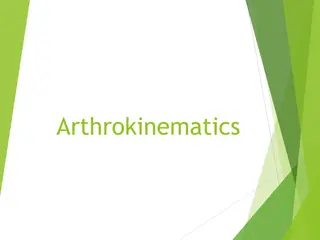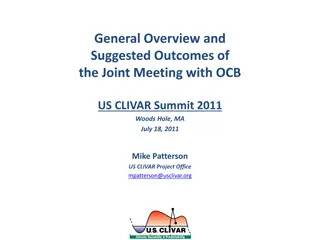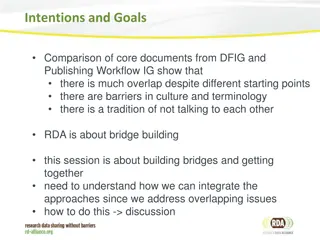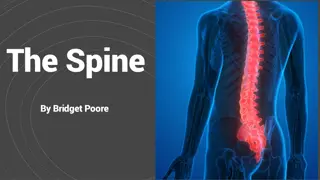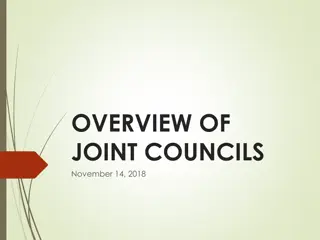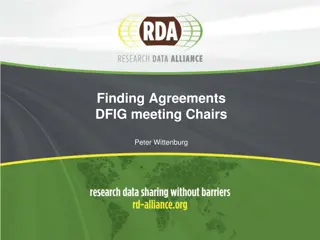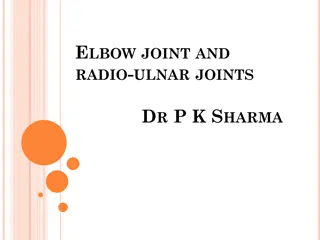Joint DFIG PWWG Meeting with Amy Nurnberger, Lary Lannom
This meeting will involve discussions with key participants Amy Nurnberger, Lary Lannom, and Peter Wittenburg. Collaboration and exchange of ideas on relevant topics are expected to be the focus. The outcome of this meeting can potentially lead to important decisions and actions. Stay tuned for updates on the progress and impact of this gathering in advancing shared goals.
Download Presentation

Please find below an Image/Link to download the presentation.
The content on the website is provided AS IS for your information and personal use only. It may not be sold, licensed, or shared on other websites without obtaining consent from the author.If you encounter any issues during the download, it is possible that the publisher has removed the file from their server.
You are allowed to download the files provided on this website for personal or commercial use, subject to the condition that they are used lawfully. All files are the property of their respective owners.
The content on the website is provided AS IS for your information and personal use only. It may not be sold, licensed, or shared on other websites without obtaining consent from the author.
E N D
Presentation Transcript
Joint DFIG PWWG Meeting Amy Nurnberger, Lary Lannom, Peter Wittenburg
Agenda Breakout 1: Discussion about Guidelines/Recommendations Breakout 2: configuration building and Minimal PID Types Breakout 4: DFIG Core Session Breakout 5: Joint session with Brokering Group Breakout 7: Joint meeting with Publishing Data Workflows 14.00 welcome and goals (Peter) 14.05 DFIG view on scientific data workflows (Peter) 14.20 PWWG view on scientific data and publishing workflows (Amy) 14.35 comparison, overlap and differences in views (Larry) 14.45 discussion (Larry and Amy) 15.30 end
Intentions and Goals comparing core documents from DFIG and Publishing Workflow IG show that there is much overlap despite different starting points there are barriers in culture and terminology there is some tradition to not talk to each other RDA is about bridge building this session is about building a bridge and get together need to understand how we can integrate the approaches since we address overlapping issues how to do this -> discussion
DFIG view on scientific data workflows Peter
Lab Reality slowly changing EU survey: 75% of researcher s time spent on DM/A M. Brodie (MIT): 80 % something is fundamentally wrong !! far away from data publication considerations are curiosity driven research and chaos twins? is DIS different? clear trends for all: data orientation, more and complex data Automatic workflows would change, but many exceptions, parameter choices, human interventions lack of experts to create flexible software solutions how can we help and change? short term and long term solutions
An illustration Feature Sets Collection X Pattern Extractor Collection Y Smart Machine Pattern Extractor Collection Z Results Iterations
An illustration Feature Sets Collection X Pattern Extractor Collection Y Smart Machine Pattern Extractor Collection Z
Data Fabric Cycle Observations Experiments Simulations etc. This slide indicated the continuous cycle of creating raw data or derived data based on collections of existing data. Identify components that could improve (stepwise).
From abstract fabrics to concrete compositions Common Components & Services Specific Components & Services Closing urgent gaps t-repositories PID system MD schemas MD editors vocabularies etc. Global Digital Object Cloud
From abstract fabrics to concrete compositions Common Components & Services Specific Components & Services Closing urgent gaps t-repositories PID system MD schemas MD editors vocabularies etc. Global Digital Object Cloud
Conclusions Collecting use cases and facts from many labs. Understand from heterogeneous practices how to come to agreed components. Addressing the data cycle in the labs where publication is often not an issue for quite some time. However the requirements for data management, accessibility and publication are getting tighter. So need to consider these requirements and map them with publication requirements. Need to provide easy transitions. Thus bridge conceptualisation & terminology. Need to overcome social barriers.
RDA/WDS Data Publishing Workflows WG + Amy Nurnberger
DPWWG Where weve been What are the current data publishing workflow landscape across disciplines and institutions?
Data publishing entities 25 data publishing entities assessed in terms of discipline, function, data formats, and roles The assignment of persistent identifiers (PIDs) to datasets, and the PID type used -- e.g. DOI, ARK, etc. Peer review of data (e.g. by researcher and by editorial review) Curatorial review of metadata (e.g. by institutional or subject repository) Technical review and checks (e.g. for data integrity at repository/data centre on ingest) Discoverability: was there indexing of the data, and if so, where? Links to additional data products (data paper; review; other journal articles) or stand-alone product Links to grant information, where relevant, and usage of author PIDs Facilitation of data citation Reference to a data life cycle model Standards compliance
Key components of data publishing Austin, C. C., Bloom, T., Dallmeier-Tiessen, S., Khodiyar, V., Murphy, F., Nurnberger, A., Whyte, A. (2016). Key components of data publishing: using current best practices to develop a reference model for data publishing. http://doi.org/10.1007/s00799-016-0178-2
Workflows Ibid
Workflows, cont. Ibid
+ What s missing?
Whats missing? This stuff
Whats missing? This stuff early interactions between researchers and a suitable data repository (or repositories), while data is processed and prepared for sharing. Dallmeier-Tiessen, S., Khodiyar, V., Murphy, F., Nurnberger, A., Raymond, L., Whyte, A. (DRAFT). Connecting data publication to the research workflow: a preliminary analysis
Whats missing? Deliberate integration of sundry products from research process, e.g., software, code, models, etc. Integration/Interoperability between data processing tools an platforms Disciplinary difference in data conception, collection, & processing Dallmeier-Tiessen, S., Khodiyar, V., Murphy, F., Nurnberger, A., Raymond, L., Whyte, A. (DRAFT). Connecting data publication to the research workflow: a preliminary analysis
Whats needed Small, modular, shareable components that help ensure platforms offer sufficient flexibility to support variety, Research workflow solutions that enable straightforward data and metadata generation in accordance with community defined and accepted standards Commit to the use of PIDs and include versioning capabilities Clear documentation that can offer direct benefits to repository depositors and users Curators Dallmeier-Tiessen, S., Khodiyar, V., Murphy, F., Nurnberger, A., Raymond, L., Whyte, A. (DRAFT). Connecting data publication to the research workflow: a preliminary analysis
